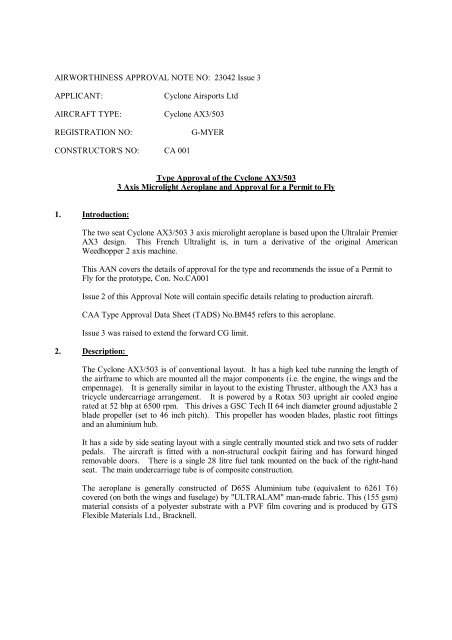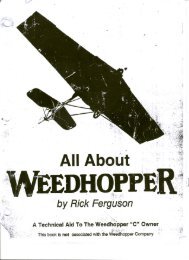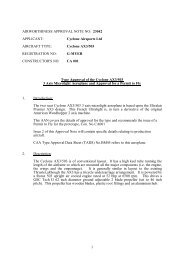Cyclone AX3 Airworthiness Approval - Weedhopper
Cyclone AX3 Airworthiness Approval - Weedhopper
Cyclone AX3 Airworthiness Approval - Weedhopper
Create successful ePaper yourself
Turn your PDF publications into a flip-book with our unique Google optimized e-Paper software.
AIRWORTHINESS APPROVAL NOTE NO: 23042 Issue 3<br />
APPLICANT:<br />
AIRCRAFT TYPE:<br />
REGISTRATION NO:<br />
<strong>Cyclone</strong> Airsports Ltd<br />
<strong>Cyclone</strong> <strong>AX3</strong>/503<br />
G-MYER<br />
CONSTRUCTOR'S NO: CA 001<br />
Type <strong>Approval</strong> of the <strong>Cyclone</strong> <strong>AX3</strong>/503<br />
3 Axis Microlight Aeroplane and <strong>Approval</strong> for a Permit to Fly<br />
1. Introduction:<br />
The two seat <strong>Cyclone</strong> <strong>AX3</strong>/503 3 axis microlight aeroplane is based upon the Ultralair Premier<br />
<strong>AX3</strong> design. This French Ultralight is, in turn a derivative of the original American<br />
<strong>Weedhopper</strong> 2 axis machine.<br />
This AAN covers the details of approval for the type and recommends the issue of a Permit to<br />
Fly for the prototype, Con. No.CA001<br />
Issue 2 of this <strong>Approval</strong> Note will contain specific details relating to production aircraft.<br />
CAA Type <strong>Approval</strong> Data Sheet (TADS) No.BM45 refers to this aeroplane.<br />
Issue3wasraisedtoextendtheforwardCGlimit.<br />
2. Description:<br />
The <strong>Cyclone</strong> <strong>AX3</strong>/503 is of conventional layout. It has a high keel tube running the length of<br />
the airframe to which are mounted all the major components (i.e. the engine, the wings and the<br />
empennage). It is generally similar in layout to the existing Thruster, although the <strong>AX3</strong> has a<br />
tricycle undercarriage arrangement. It is powered by a Rotax 503 upright air cooled engine<br />
rated at 52 bhp at 6500 rpm. This drives a GSC Tech II 64 inch diameter ground adjustable 2<br />
blade propeller (set to 46 inch pitch). This propeller has wooden blades, plastic root fittings<br />
and an aluminium hub.<br />
It has a side by side seating layout with a single centrally mounted stick and two sets of rudder<br />
pedals. The aircraft is fitted with a non-structural cockpit fairing and has forward hinged<br />
removable doors. There is a single 28 litre fuel tank mounted on the back of the right-hand<br />
seat. The main undercarriage tube is of composite construction.<br />
The aeroplane is generally constructed of D65S Aluminium tube (equivalent to 6261 T6)<br />
covered (on both the wings and fuselage) by "ULTRALAM" man-made fabric. This (155 gsm)<br />
material consists of a polyester substrate with a PVF film covering and is produced by GTS<br />
Flexible Materials Ltd., Bracknell.
The two spar, double-surface wing has the profile formed by battens, rather than ribs. There is<br />
a conventional elevator trim tab fitted to the aircraft. It has no flaps.<br />
The <strong>Cyclone</strong> <strong>AX3</strong>/503 microlight is largely manufactured by Ultralair SA in France. The<br />
modifications to the French design found to be necessary for full compliance with BCAR<br />
Section S have been incorporated into the declared UK design standard. This is controlled<br />
exclusively by <strong>Cyclone</strong> Airsports and is used by Ultralair SA for the manufacture of the UK<br />
machines.<br />
3. Basis for <strong>Approval</strong>:<br />
The <strong>Cyclone</strong> <strong>AX3</strong>/503 has been assessed against BCAR Section S Advance Issue, March l983<br />
as revised ll October l988. CAA paper S866 was also used as a basis for establishing an<br />
acceptable test factor for the composite components.<br />
Statements of absolute compliance with Section S have been accepted for all except the<br />
following requirements:-<br />
S 23 a) Load Distribution Limits<br />
S474 Landing Case - Strength<br />
S689 b) Cable Systems<br />
Either alternative means of compliance or derogations have been accepted for these, as detailed<br />
in paragraph 4 below.<br />
4. Technical Investigation:<br />
A formal Type <strong>Approval</strong> process has been carried out with this microlight aeroplane.<br />
The resulting type approval data is given in CAA TADS No.BM45<br />
4.1 The submitted documents forming the basis of the approval are as follows:-<br />
4.1.1 Design & Structural Substantiation:<br />
The bulk of the compliance submission is contained in <strong>Cyclone</strong> Airsports<br />
Compliance Checklist, document TAS/<strong>AX3</strong>/1/92, at Issue 4.<br />
It contains the details of compliance with subparts A,C,D,E,F,G and J of<br />
Section S. The Appendices to this report contain details of the structural and<br />
functional tests forming the basis of the compliance statements.<br />
4.1.2 Flight Test Substantiation:<br />
The document <strong>Cyclone</strong> <strong>AX3</strong>-Flight Test Report at Issue 1 as amended by<br />
<strong>Cyclone</strong> Airports letter of 12 August 1992 gives the details of the tests<br />
conducted to demonstrate compliance with Subpart B of<br />
Section S.<br />
4.1.3 Definition of Design:<br />
The <strong>Cyclone</strong> <strong>AX3</strong>/503 design standard is defined by "top drawing" document<br />
reference <strong>AX3</strong>-001 at Issue 1.<br />
This document gives details of all the drawings comprising the design<br />
standard, both those originally drawn by Ultralair SA (and adopted as part of<br />
the UK design) and those generated by <strong>Cyclone</strong> Airsports themselves.<br />
2
4.1.4 Owners Manual:<br />
<strong>Cyclone</strong> <strong>AX3</strong>/503 Owners Manual Issue 1 contains the information required by<br />
Section S from both the Pilots Handbook and the Maintenance Manual.<br />
4.2 Alternative means of Compliance and Derogations<br />
4.2.1 Load distribution limits (S23a))<br />
Due to the lack of availability of a suitable pilot the full declared range of<br />
centre of gravity positions at minimum weight was not demonstrated.<br />
Sufficient arguments have been presented by <strong>Cyclone</strong> Airports for this to have<br />
been deemed acceptable. Also see paragraph 4.4.<br />
4.2.2 Landing Case - Strength (S474)<br />
The conditions upon which the testing of the composite main undercarriage<br />
axle has been accepted are given in CAA Internal Memo on the subject of 21st<br />
May 1992.<br />
4.2.3 Cable Systems (S689b))<br />
Neither the aileron or rudder pulley banks in the vicinity of the control stick<br />
are in agreement with the recommendations of the interpretation material to<br />
S689b).<br />
These pulley has been accepted in this instances based upon their satisfactory<br />
usage in the existing French Ultra light aircraft and by 'hard lifing' both sets of<br />
cables in the maintenance schedule.<br />
4.3 Differences between Con. No. CA001 and the Type Approved Design Standard<br />
The prototype aircraft CA001 differs from the design standard (ref 4.1.3 above) in the<br />
following respects:<br />
The airspeed indicator reads in km/h, rather than mph.<br />
Two fuel pressure gauges are included on the panel.<br />
Alternative wing mounting positions are present on the keel tube, resulting<br />
from development work during type approval.<br />
Strut fittings have welded undercarriage stop pick ups.<br />
Main undercarriage tube has additional mounting holes.<br />
Rear Wing struts have additional mounting holes.<br />
Aileron cable is spliced.<br />
4.4 Extended forward CG position<br />
BMAA MAAN 1510 Issue 1 dated 19 June 2000 approves the extension to the<br />
forward CG position from 866 mm AOD to 849 mm AOB. The aircraft's<br />
manufacturer has issued a statement of no technical objection. Pegasus Flight Test<br />
Report FTR/<strong>AX3</strong>/CG/14600 dated 14/6/00 refers.<br />
3
5. Weight & Balance:<br />
6. Noise:<br />
7. Radio:<br />
The weight on Centre of Gravity envelope for the type is as defined in the Owners Manual<br />
referred to in paragraph 10. The forward CG limit shall be changed from 866 mm to 849 mm..<br />
The maximum weight is unchanged.<br />
Noise Type Certification No.141 M has been issued for this aeroplane type fitted with a Rotax<br />
503 upright air cooled engine and GSC Tech II 2-bladed (square tip) propeller, 64 inch<br />
diameter, set at 46 inch pitch.<br />
The design standard does not include radio equipment or aerial installations.<br />
An external comms aerial mount is fitted, however to the aircraft as standard.<br />
8. Flight Testing:<br />
Details of the test flying undertaken by <strong>Cyclone</strong> Airsports are covered in paragraph 4.1.2.<br />
Details of the CAA evaluation flight test for Type <strong>Approval</strong> are given in CAA Test Report<br />
FTR/8346P, dated l0th July 1992. The report concludes that the aircraft's flying qualities were<br />
acceptable for the issue of a Permit to Fly.<br />
9 Placards & Limitations:<br />
As detailed in CAA TADS BM45 Issue 3 or later revision.<br />
10. Flight Manual/Maintenance Manual:<br />
Reference paragraph 4.1.4.<br />
11. Inspection:<br />
The aeroplane has been inspected by the CAA and was found to conform to the <strong>Cyclone</strong><br />
<strong>AX3</strong>/503 Type <strong>Approval</strong> Data Sheet No. BM.45 Issue l and to the drawing schedule referred<br />
to in paragraph 4.1.3 as amended by 4.3.<br />
12. <strong>Approval</strong>:<br />
This aeroplane G-MYER, constructors number CA001 and any other of the type is approved<br />
for the issue of a Permit to Fly provided it is operated in accordance with the manual referred<br />
toinparagraph10ofthisAANandtotheTADS.<br />
RJHardy<br />
..........................................................<br />
Surveyor (Inspection)(Avionics)<br />
Date 22 June 2000<br />
4










